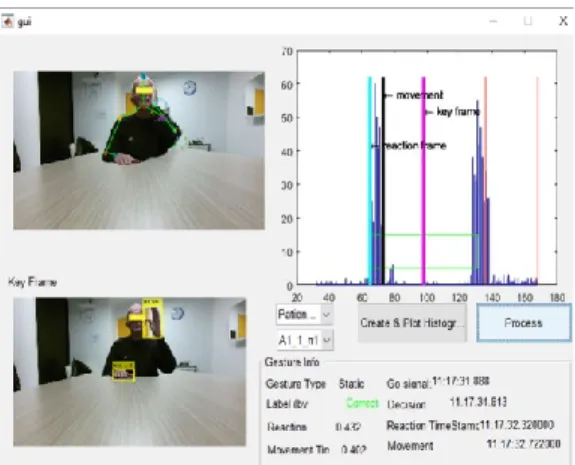HAL Id: hal-01849278
https://hal.inria.fr/hal-01849278
Submitted on 25 Jul 2018
HAL is a multi-disciplinary open access
archive for the deposit and dissemination of
sci-entific research documents, whether they are
pub-lished or not. The documents may come from
teaching and research institutions in France or
abroad, or from public or private research centers.
L’archive ouverte pluridisciplinaire HAL, est
destinée au dépôt et à la diffusion de documents
scientifiques de niveau recherche, publiés ou non,
émanant des établissements d’enseignement et de
recherche français ou étrangers, des laboratoires
publics ou privés.
A Gesture Recognition Framework for Cognitive
Assessment
Farhood Negin, Jérémy Bourgeois, Philippe Robert, Francois Bremond
To cite this version:
Farhood Negin, Jérémy Bourgeois, Philippe Robert, Francois Bremond. A Gesture Recognition
Frame-work for Cognitive Assessment. Gerontechnology, ISG International Society for Gerontechnology,
2018, 17 (s), �10.4017/gt.2018.17.s.164.00�. �hal-01849278�
F. Negin, J. bourgeois, P. Robert, F. Bremond. A Gesture Recognition Framework for
Cognitive Assessment. Gerontechnology 2018; 17(Suppl.):<page>. Purpose: Most
developed countries have been confronted with an acute growth in their elderly population. This situation is accompanied by increased prevalence of several health issues decreasing their quality of life. Alzheimer's disease is one of the most common cognitive disorders associated with aging. This has resulted in an urge to take advantage of technological tools to help doctors by providing early diagnosis which is vital for treatment of the elderly. These patients are not able to correctly emulate forelimb gestures and commit spatial/temporal errors, e.g. pretend to strike a nail with a hammer.1 We developed a gesture recognition and evaluation tool to assist doctors in early detection of cognitive disorders (Figure 1). The framework performs precise gesture recognition based on state-of-the-art computer vision algorithms and evaluates subjects’ performances to obtain a diagnostic report for clinicians.
Method: The gesture recognition part of the framework uses four different methods. The first
method employs local descriptors such as HOG/HOF2 using shape and motion cues of a person performing a gesture. In the second method, skeleton information of the subjects is used to benefit from the body pose information. The third method uses depth information to detect exact hand patches with body part trajectories. We also trained a deep learning based recognition model3 which empowered the framework to perform reliable recognitions.
Results and Discussion: The framework is trained to recognize correct/incorrect
performances. To have an objective decision on correctness of the gesture performances, clinicians annotated the data used for training the recognition algorithms. The utilized dataset was collected at the Institute Claude Pompidou (ICP) at Nice consisting of 14 dynamic and 15 static gestures selected by clinicians. The framework achieved 90% average accuracy on classifying gestures which is a reliable rate for diagnosis. Additionally, reaction and movement time of a subject are also detected. These two motor reflex criteria which measures responsive level of a subject are important factors in cognitive diagnosis. Motion descriptors are utilized to detect those quantities. All these types of information are illustrated in the user interface which provides clinicians with a detailed assessment of individual gesture and overall performance (Figure 1).
Conclusion: We developed a user-friendly tool to help doctors in the diagnosis of cognitive
disorders by providing a complete assessment of gestures performed by subjects.
Future Work: We will conduct extensive evaluations on a larger population of patients with
different levels of cognitive disorders. To improve gesture recognition task, more accurate deep models will be investigated.
References
1. Mozaz, M., Garaigordobil, M., Rothi, L.J.G., Anderson, J., Crucian, G.P., Heilman, K.M., 2006. Posture recognition in alzheimers disease. Brain and cognition 62, 241–245.
2.Wang, H. and Schmid, C., 2013. Action recognition with improved trajectories. IEEE
in-ternational conference on computer vision
3551-3558.
3. Hochreiter, S. and Schmidhuber, J., 1997. Long short-term memory. Neural
computa-tion, 9(8).1735-1780.
Keywords: Human computer interaction, Computer assisted diagnosis
Address: STARS team - INRIA Sophia Antipolis, 06902 Valbonne, France; E: farhood.negin@inria.fr
